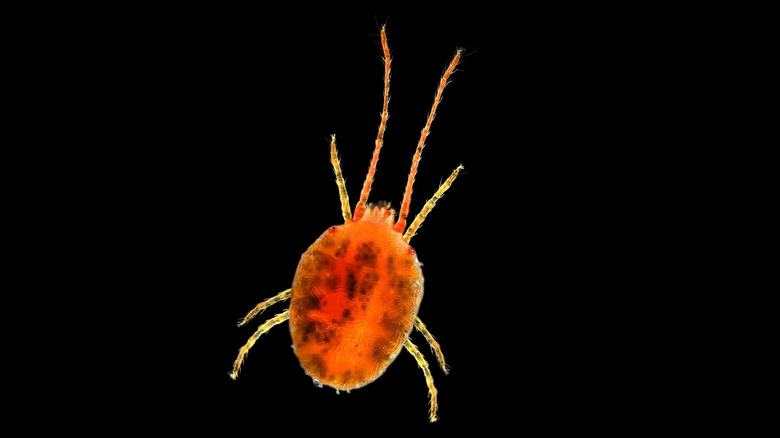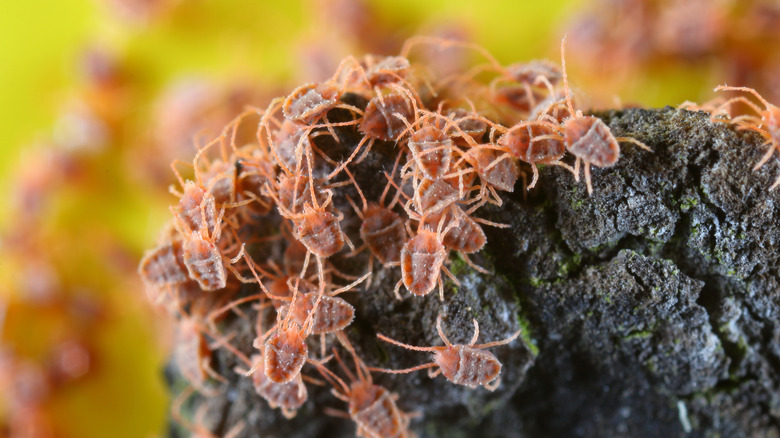What Are Those Tiny Red Bugs You See Crawling Around?
Springtime is a joy for many of us as we shake off our winter blues and start getting out of the house more. Unfortunately, it can also mean unwanted visitors getting into the house as well. As the weather warms up, you might start finding clusters of tiny little red bugs crawling around your house, particularly around the doors and window frames. At first glance, you might think these insects look like bed bugs, but you needn't panic. Not only are they not bed bugs; they aren't even insects.
Those little red bugs are called clover mites (Bryobia praetiosa), a species of tiny arachnid found on every continent except for Antarctica. Their bodies are only 0.75–0.85 millimeters long, but that actually makes them large by mite standards. Clover mites also stand out from other common house mites due to two things: their red-green coloring (unusual among mites found indoors) and their front legs. As arachnids, all mites possess eight legs, but in clover mites, the two front legs are about twice as long as the other legs, and roughly as long as the mite's body, looking more like a pair of antennae.
You'll be relieved to know that clover mites are not among the mites that fly and bite, and they pose no threat to humans or other animals. They eat only plants, and are drawn to human settlements by their attraction to fertilized lawns. Their rise as a common pest correlates to increased fertilizer use and lawn popularity over the second half of the 20th century.
Clover mites have a very unusual reproductive cycle
One of the most notable things about clover mites is the fact that they are asexually reproducing organisms. Rather than having a male's sperm fertilize a female's egg — as their larger arachnid cousins, the spiders, do — clover mites use parthenogenesis, a system of asexual reproduction in which offspring develop from eggs without any fertilization required. All clover mites are female, as far as we know, with no male specimens ever having been observed.
Each clover mite lays roughly 70 eggs. After hatching, the offspring go through four life stages: larva, protonymph, deutonymph, and finally adulthood. They do not develop their final two legs until the protonymph phase. The entire life cycle plays out in just a few weeks, and a single year will see five or six generations of clover mites hatch.
Clover mites are most active in the late springtime because they prefer temperatures in the range of 70–85 degrees Fahrenheit. When temperatures get too cold or too hot, both the mites and their eggs will go into a dormant state. Their eggs can often be found tucked away in small crevices, both in naturally-occurring places like tree bark, and human environments like sidewalk cracks and in the walls of buildings. When the climate returns to a favorable state, the eggs will end their dormancy, and thousands of clover mite larvae will hatch and spread, sometimes to places we'd rather they stayed away from.
What to do about clover mites in your home
Clover mites do not pose any danger, but they are a nuisance. If you find your home infested by them, the most important thing to know is, never squash a clover mite. A firm stomp is many people's first instinct upon seeing a bug in their vicinity, but smashing a clover mite will leave a red stain in its wake that becomes even more of a nuisance than the pest itself. The only effective way to remove clover mites from your home is to suck the clusters up with a vacuum, but you must be sure to immediately dispose of the vacuum bag so that the mites cannot escape back out. A simpler option is to just wait the mites out, knowing that as soon as temperatures get too cold or too hot, they will disappear into dormancy again.
Prevention is the real way to spare yourself the headache of clover mites. If clover mites are even reaching your home in the first place, it's likely because you have a lawn or other vegetation growing right up against the building. Keeping a strip of plant-free land about three feet wide around your house will effectively act as a moat around an old castle, keeping clover mites out. The other key measure to take is ensuring that there are no openings for mites to travel through by searching out and caulking any cracks around your windows or the exterior of your house.


